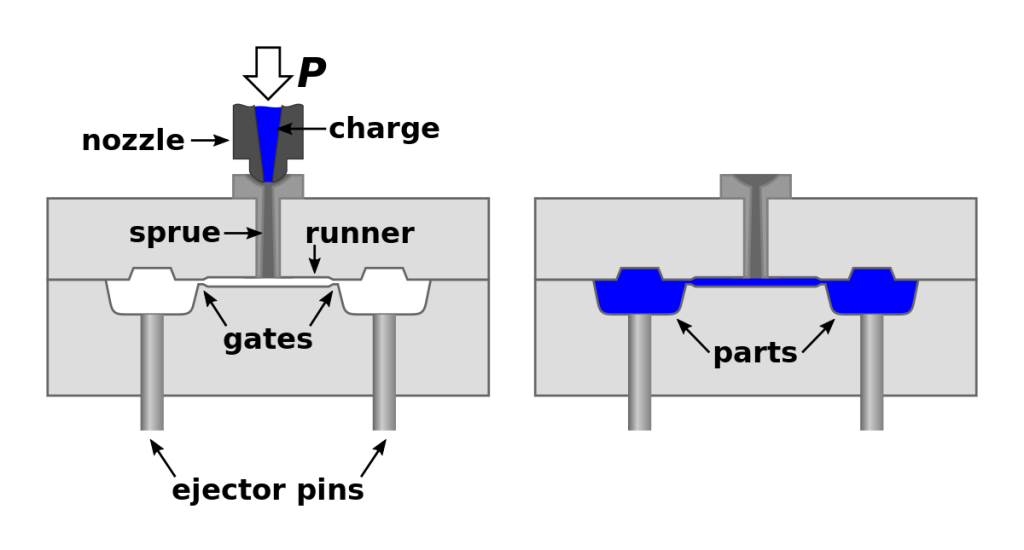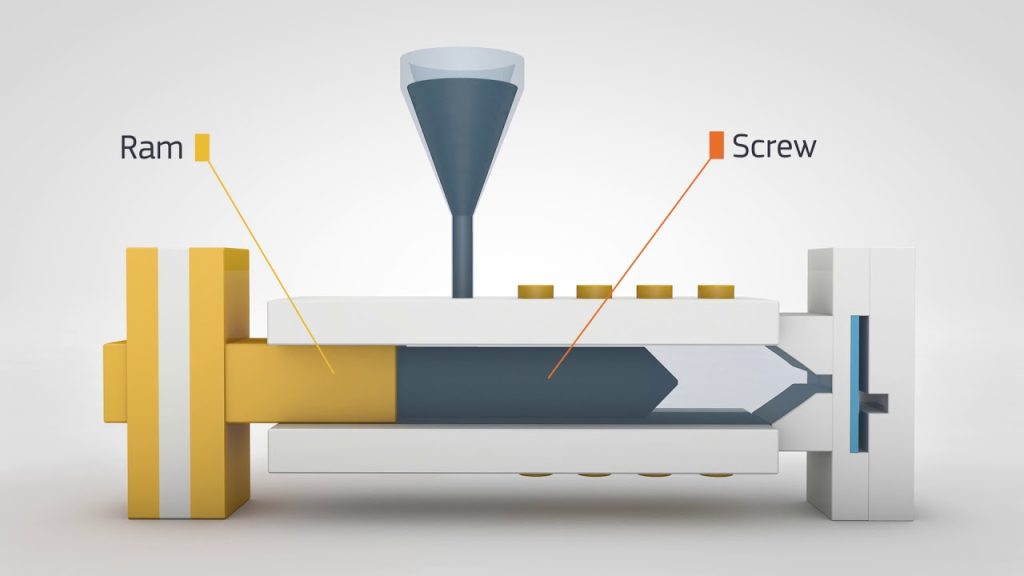Injection molding is a widely used manufacturing process for producing high-quality plastic parts. However, one common issue that arises during this process is flow marks. These marks appear as visible lines or streaks on the surface of the molded part and can negatively affect the part’s appearance and performance. In this article, we will explore some effective ways to reduce flow marks in injection molding and produce parts that meet the desired quality standards. So, let’s dive in and learn how to improve the injection molding process!
If you want to reduce flow mark in injection molding, you can try adjusting the injection speed or pressure, increasing the mold temperature, or using a mold release agent. Additionally, you can modify the gate location, reduce the wall thickness, or increase the cooling time. It’s important to note that the specific solution may depend on the type of material and design of the part being molded.
How to Reduce Flow Mark in Injection Molding?
Flow marks are a common problem in injection molding that can affect the appearance and strength of the final product. These marks are caused by variations in the flow of melted plastic as it is injected into the mold. Fortunately, there are several steps you can take to reduce flow marks and produce high-quality injection-molded parts.
1. Optimize Injection Speed and Pressure
The injection speed and pressure have a significant impact on the flow of melted plastic, and therefore on the appearance of the final product. If the injection speed is too high, it can cause turbulence in the melted plastic and lead to flow marks. Similarly, if the injection pressure is too high, it can cause the plastic to flow too quickly and result in flow marks.
To reduce flow marks, it is essential to optimize the injection speed and pressure parameters. This can be achieved by conducting a thorough analysis of the mold and the plastic material being used, as well as by adjusting the injection parameters until the desired results are achieved.
2. Use High-Quality Plastic Material
The quality of the plastic material used in injection molding can also have a significant impact on flow marks. If the plastic material is of poor quality or has impurities, it can cause variations in the flow of melted plastic and lead to flow marks.
To reduce flow marks, it is important to use high-quality plastic material that is free of impurities and defects. This can be achieved by working with a reputable supplier who can provide high-quality plastic material that meets your specific requirements.
3. Properly Design the Mold
The design of the mold can also impact the flow of melted plastic and the appearance of the final product. If the mold is not properly designed, it can cause variations in the flow of melted plastic and lead to flow marks.
To reduce flow marks, it is essential to properly design the mold. This can be achieved by working with an experienced mold designer who can create a mold that is optimized for your specific injection molding needs.
4. Use Mold Temperature Control
The temperature of the mold can also impact the flow of melted plastic and the appearance of the final product. If the mold is too hot or too cold, it can cause variations in the flow of melted plastic and lead to flow marks.
To reduce flow marks, it is important to use mold temperature control. This can be achieved by using a temperature control system that can regulate the temperature of the mold to ensure that it is at the optimal temperature for injection molding.
5. Optimize Gate Design
The gate design can also impact the flow of melted plastic and the appearance of the final product. If the gate design is not optimized, it can cause variations in the flow of melted plastic and lead to flow marks.
To reduce flow marks, it is essential to optimize the gate design. This can be achieved by working with an experienced mold designer who can create a gate design that is optimized for your specific injection molding needs.
6. Reduce the Injection Time
The injection time can also impact the flow of melted plastic and the appearance of the final product. If the injection time is too long, it can cause variations in the flow of melted plastic and lead to flow marks.
To reduce flow marks, it is important to reduce the injection time. This can be achieved by optimizing the injection speed and pressure parameters, as well as by reducing the thickness of the plastic material being injected.
7. Use Proper Venting
Venting is essential in injection molding to allow air to escape from the mold cavity as the plastic material is injected. If the mold is not properly vented, it can cause variations in the flow of melted plastic and lead to flow marks.
To reduce flow marks, it is important to use proper venting. This can be achieved by working with an experienced mold designer who can create a mold that is properly vented for your specific injection molding needs.
8. Use Proper Injection Molding Machine
The injection molding machine used can also impact the flow of melted plastic and the appearance of the final product. If the injection molding machine is not properly calibrated or maintained, it can cause variations in the flow of melted plastic and lead to flow marks.
To reduce flow marks, it is important to use a proper injection molding machine. This can be achieved by working with a reputable supplier who can provide high-quality injection molding machines that are properly calibrated and maintained.
9. Conduct Regular Maintenance
Regular maintenance of the injection molding equipment is essential to ensure that it is functioning properly and producing high-quality parts. If the equipment is not properly maintained, it can cause variations in the flow of melted plastic and lead to flow marks.
To reduce flow marks, it is important to conduct regular maintenance of the injection molding equipment. This can be achieved by following the manufacturer’s recommended maintenance schedule and conducting regular inspections of the equipment.
10. Train Your Staff
Finally, it is essential to train your staff in proper injection molding techniques to ensure that they are producing high-quality parts. If your staff is not properly trained, they may not be able to identify and correct issues that can lead to flow marks.
To reduce flow marks, it is important to train your staff in proper injection molding techniques. This can be achieved by providing regular training sessions and ensuring that your staff is up-to-date on the latest injection molding techniques and technologies.
In conclusion, reducing flow marks in injection molding requires a thorough understanding of the injection molding process and the factors that can impact the flow of melted plastic. By optimizing injection parameters, using high-quality plastic material, properly designing the mold, using mold temperature control and proper venting, using a proper injection molding machine, conducting regular maintenance, and training your staff, you can reduce flow marks and produce high-quality injection-molded parts.
Frequently Asked Questions
Injection molding is a widely used manufacturing process that produces a large number of plastic products. However, one of the most common issues in injection molding is flow marks. These marks can be unsightly and can affect the product’s quality. In this article, we answer some frequently asked questions about how to reduce flow marks in injection molding.
What are flow marks in injection molding?
Flow marks are a common defect in injection molding. These marks appear on the surface of the plastic part and are caused by the flow of molten plastic into the mold. Flow marks can be in the form of lines, streaks, or waves, and they can be visible or invisible.
Flow marks are caused by a variety of factors, including the design of the mold, the properties of the plastic material, and the processing parameters. The most common cause of flow marks is the injection speed, which can affect the flow of molten plastic into the mold.
How can flow marks be reduced in injection molding?
There are several ways to reduce flow marks in injection molding, including adjusting the injection speed, increasing the mold temperature, and changing the plastic material.
One effective method is to reduce the injection speed, which can help the molten plastic flow more smoothly into the mold. Increasing the mold temperature can also help reduce flow marks by reducing the viscosity of the plastic material. Another option is to use a plastic material with a lower viscosity, which can improve the flow of the molten plastic into the mold.
How can the mold design affect flow marks in injection molding?
The design of the mold can have a significant impact on flow marks in injection molding. A poorly designed mold can cause uneven flow of the molten plastic, resulting in flow marks.
To avoid this issue, it is important to design the mold with a uniform wall thickness and proper gating and runner systems. The mold should also be properly vented to allow air to escape during the injection molding process.
Can the injection molding machine affect flow marks?
Yes, the injection molding machine can affect flow marks in injection molding. The machine’s pressure, temperature, and speed settings can all impact the flow of the molten plastic into the mold.
To reduce flow marks, it is important to select the right machine and set the processing parameters correctly. The machine should be capable of providing consistent pressure and temperature during the injection molding process.
How can the operator reduce flow marks in injection molding?
The operator plays an important role in reducing flow marks in injection molding. They can monitor the injection molding process and make adjustments as needed.
For example, the operator can adjust the injection speed, mold temperature, and plastic material to reduce flow marks. They can also inspect the mold for any design issues and make sure it is properly vented. Finally, the operator can ensure that the machine is properly maintained and that the processing parameters are set correctly.
In conclusion, reducing flow marks in injection molding requires attention to several key factors. First and foremost, ensuring that the mold is properly designed and manufactured is crucial. This involves optimizing gate placement, runner design, and cooling channels to minimize pressure variations and promote even flow.
Secondly, selecting the right material for the job can also make a significant difference in reducing flow marks. Materials with high viscosity or high melt flow rates may be more prone to flow marks, so choosing a material with a more suitable flow rate can help minimize their appearance.
Finally, adjusting processing parameters such as temperature, pressure, and injection speed can also help to reduce flow marks. Fine-tuning these settings can help to optimize the flow of the material and reduce the likelihood of pressure variations that can lead to flow marks.
By paying close attention to these factors and implementing strategies to minimize flow marks, injection molding professionals can produce high-quality parts with minimal cosmetic defects, improving both their bottom line and their reputation in the industry.
Request a quote today!
[contact-form-7 id="1578" title="Contact form"]
Please compress the file into a ZIP or RAR file before uploading. Alternatively, send through your RFQ by email.
enquires@unitymanufacture.com





